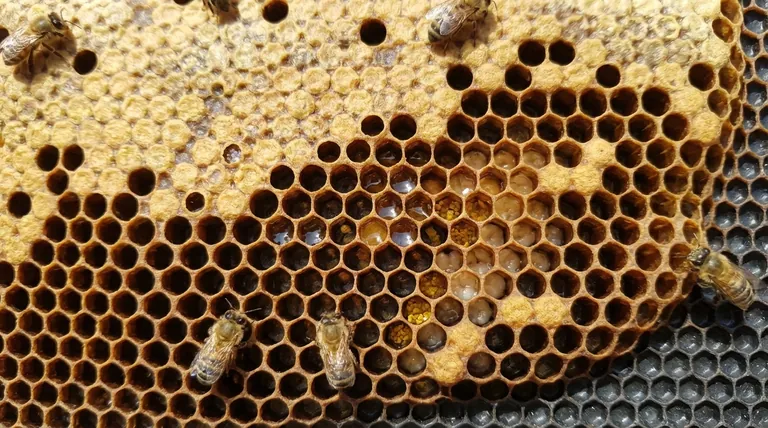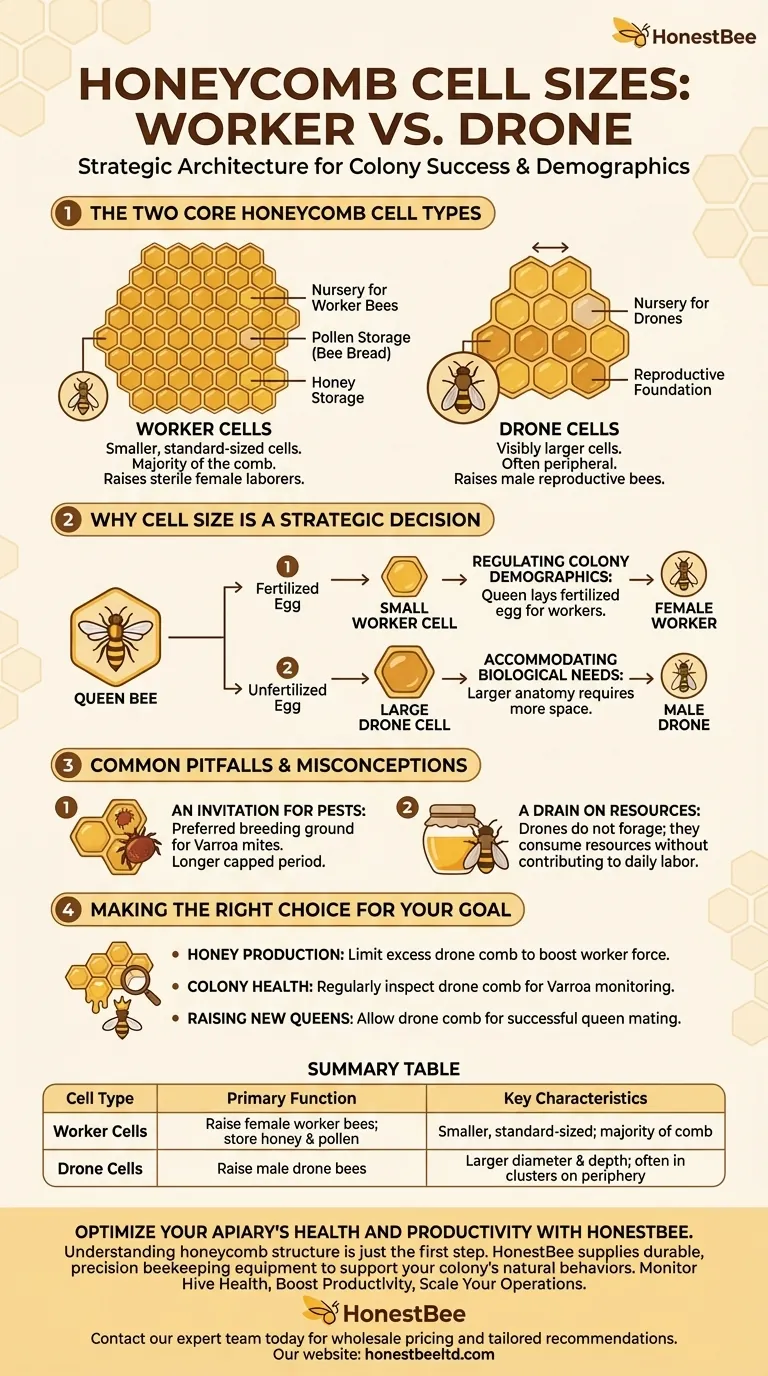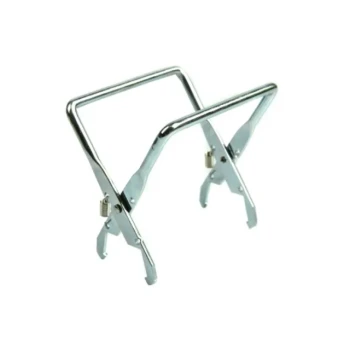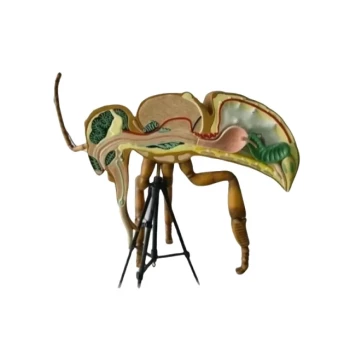To be precise, honey bees construct two primary sizes of honeycomb cells to house the two main castes of bees within a colony. These are the smaller worker-sized cells and the visibly larger drone-sized cells. This architectural distinction is not arbitrary; it is a fundamental strategy for regulating the colony's demographics, managing resources, and ensuring its reproductive future.
The existence of two cell sizes is a direct reflection of the hive's social structure. The size of the cell dictates the type of bee that can be raised within it, giving the queen and the colony precise control over their population.

The Two Core Honeycomb Cell Types
A honeycomb is far from a uniform structure. It is a dynamic blueprint for the colony's growth, with each cell size serving a distinct and critical purpose.
Worker Cells: The Hive's Engine Room
The vast majority of cells in any honeycomb are worker cells. These are the smaller, standard-sized hexagonal cells.
Their primary function is to serve as the nursery for female worker bees, the sterile bees that perform all the labor of the hive, from foraging to nursing the young.
These cells are also used for the primary storage of both pollen (bee bread) and honey, which feed the colony.
Drone Cells: The Reproductive Foundation
Bees also construct drone cells, which are noticeably larger in diameter and depth than worker cells.
These cells are built specifically to raise drones, the male bees of the colony. Because drones are physically larger and more robust than workers, they require a larger cell to develop properly.
Drone cells are typically built in smaller clusters, often along the bottom or periphery of the comb, and their construction is more seasonal, peaking when the colony is strong and preparing to reproduce.
Why Cell Size is a Strategic Decision
The decision to build one cell size over another is a calculated one, driven by the biological needs and long-term goals of the colony.
Accommodating Biological Needs
The most straightforward reason for the size difference is anatomy. A male drone bee simply cannot fit into a standard worker cell during its larval and pupal stages.
The larger cell provides the necessary space for the drone to grow to its full size before emerging as an adult.
Regulating Colony Demographics
Cell size is the primary mechanism the queen uses to control the hive's population balance. She will lay a fertilized egg in a smaller worker cell, which develops into a female worker.
Conversely, she lays an unfertilized egg in a larger drone cell, which develops into a male drone. This gives the colony deliberate control over its investment in workers versus reproductive males.
Common Pitfalls and Misconceptions
Understanding the function of drone comb is critical for any beekeeper, as mismanaging it can have negative consequences for the hive.
An Invitation for Pests
The larger size of drone cells and their longer capped period make them a preferred breeding ground for the hive's most destructive parasite: the Varroa mite.
Beekeepers often intentionally remove sections of drone comb as a non-chemical method of controlling Varroa populations, as trapping and removing the mites with the drone brood can significantly reduce a hive's parasite load.
A Drain on Resources
Drones do not forage for nectar, produce wax, or care for the young. Their sole purpose is to mate with a new queen.
While essential for the species, an excessive drone population can become a significant drain on a colony's food resources without contributing to its daily productivity. A healthy colony instinctively manages this balance.
Making the Right Choice for Your Goal
For a beekeeper, interpreting the bees' construction choices provides deep insight into the state and intentions of the colony.
- If your primary focus is honey production: Limiting excess drone comb can encourage the colony to invest more energy in raising worker bees, which directly increases the foraging workforce.
- If your primary focus is colony health: Regularly inspecting drone comb is one of the most effective ways to monitor for Varroa mites and intervene before an infestation becomes critical.
- If your primary focus is raising new queens: Allowing the colony to build drone comb and raise healthy drones is a necessary step to ensure your new queens can be successfully mated.
Ultimately, recognizing the difference between a worker and a drone cell is to understand the fundamental language of the colony's health, needs, and future ambitions.
Summary Table:
| Cell Type | Primary Function | Key Characteristics |
|---|---|---|
| Worker Cells | Raise female worker bees; store honey & pollen | Smaller, standard-sized hexagonal cells; make up the majority of the comb |
| Drone Cells | Raise male drone bees | Larger in diameter and depth; often built in clusters on comb periphery |
Optimize Your Apiary's Health and Productivity with HONESTBEE
Understanding the intricacies of honeycomb structure is just the first step. For commercial apiaries and equipment distributors, managing cell construction is key to controlling Varroa mite populations and maximizing honey production. HONESTBEE supplies the durable, precision beekeeping equipment you need to support your colony's natural behaviors effectively.
We provide wholesale-focused solutions to help you:
- Monitor Hive Health: Use equipment designed for easy inspection of drone comb for mite checks.
- Boost Productivity: Encourage optimal worker bee populations with well-designed frames.
- Scale Your Operations: Reliable, commercial-grade supplies delivered to meet your demands.
Let's discuss how our supplies can strengthen your operation. Contact our expert team today for wholesale pricing and tailored recommendations.
Visual Guide

Related Products
- Food Grade Plastic bee Foundation for Bee Frames
- Electric Flatting and Embossing Machine with Tray for Beekeeping
- Colorful Silicone Beeswax Foundation Mold Mould for Beekeeping
- Electric Beeswax Foundation Machine With Operating Tray and Wax Foundation Roller
- JZBZ Type Wide Base Plastic Queen Cell Cups for Base Mounting and Queen Rearing
People Also Ask
- What additional step can improve the performance of plastic foundation in the hive? Apply a Generous Coat of Beeswax
- What factors should beekeepers consider when choosing between beeswax and plastic foundation? A Guide to Durability vs. Natural Philosophy
- Why is it beneficial to coat plastic foundation with beeswax? Boost Hive Acceptance & Comb Building
- Why do commercial beekeepers prefer plastic foundation? Durable, Reusable, and Cost-Effective
- How to get bees to draw out plastic foundation? Boost Comb Building with Proven Tactics


















